Subject: Friend, The Lightest Electric Guitar and Quick Chord Changes
You are getting this e-mail because you subscribed to it on www.learn-to-play-rock-guitar.com. If you don't want to receive these e-mails any longer, go to the bottom of this message and click on "unsubscribe." Hey there Friend, I thought we'd take a little break from the fingerboard memorization and theory and get back to some questions you guys have asked.OK, here's one from Abid. He asks, "What electric guitars are the lightest in weight?" My answer - Air Guitars. OK, seriously, these are the lightest electric guitars in the world. Give one a try. They are lighter than air! You can get a professional air guitar here. There are a a few designs to choose from. I think my favorite is the double-neck. Perhaps those are a bit pricey, so if you are up to the challenge, you may want to build your own air guitar. One of the best tonewoods for an air guitar is Mount Airy mahogany (grown in North Carolina), if you can find it. It is very rare and rather expensive, but totally worth it! If you need to have something a bit more "tangible" to practice with, get the Air Guitar Pro. Kind of like training wheels for air guitar mastery. And for those competitors really lacking imagination, visit my guitar store. You won't get the lightest electric guitar here, but you'll at least be able to master your technique! If you think you're already good enough, watch for an announcement of the regional competitions. They have yet to put out a schedule, but based on last year's, the competition should run over the summer. Are you already a serious competitor? Think you got what it takes to go all the way - ready to take on the monsters of air guitardom? Make plans to be at The Air Guitar World Championship in Finland! Only there will you be able to prove to all the world your mastery of this beautiful and awe-inspiring instrument! If perhaps an air guitar is too light for you, let's look at what the primary driver for a guitar's heft is. The weight of a guitar is somewhat influenced by the tonewoods used to make the guitar and the basic design. Many guitar bodies and necks are made of solid mahogany, guitars like the Gibson SG and Explorer. These guitars are lighter in weight than say a Gibson Les Paul, which combines a mahogany body with a maple top. Fender guitars tend to be solid alder or maple and tend to be heavier compared to the Gibsons. There are even guitars made from pine that should be lighter than others made from denser woods. There are arguments about the quality of tone from using different woods, but ultimately your tone comes from your fingers and technique. You could take a cheap department store guitar and have it sound fantastic in the hands of a great player. Semi-hollow body and hollow body guitars will be lighter than solid body guitars. Some solid body guitars have chambers routed out to decrease weight and give a different tone to the guitar, while others consist of a solid block of wood, or pieces glued together. As you can see, Abid, there are many different factors to consider when you're looking for a nice light guitar. Best advice is to get out there to the local guitar store and check out a few instrument. Find one that feels good in your hands and is a weight you can manage. Obviously if you're on stage with your guitar strapped on, the weight can become an issue if you're not used to it, so make sure you have a strap with you so you can feel the weight of the guitar on your shoulder. It's up to you to decide what your tolerance level is when it comes to the guitar weight, so try out a few different makes and models before you choose one to take home. I think we have time for one more... hmm, let's see, Daniel says "my biggest problem is switching between chords quick!!" Seems like I've seen that one before, so I guess we'll have a go at it. The first thing you need to make sure you're doing is using the suggested finger positions for each chord. Believe it or not, there is a reason for the strange and foreign contortions you're forcing your fingers to make. You will have to become comfortable with these finger positions, but once you are, they will be second nature - you won't even have to think about it. While it might not seem like it at first, the finger positions were designed to help you be able to change positions quickly between chords. Let's look at a couple examples. Try this chord change. First play C major chord in the open position. Use this fingering: 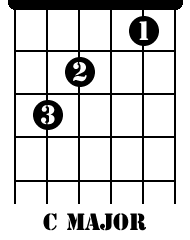 Now play an Am (A minor) chord 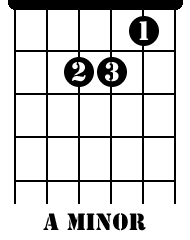 Notice that when you change from the C to the Am chord, your index and middle fingers do not move - only your ring finger changes position from the third fret on the fifth string (C note on the A string) to the second fret on the third string (A note on the G string). 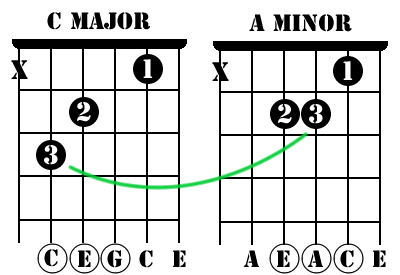 Here's another example. Play a D major chord in the open position. Here's the fingering for the D chord: 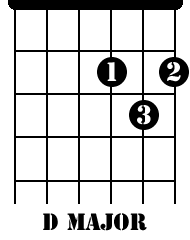 Change to the A major chord: 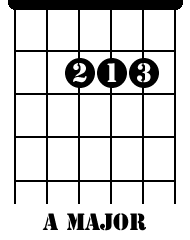 In this chord change, you've moved both your middle and ring fingers, but the index finger has stayed in the same position. 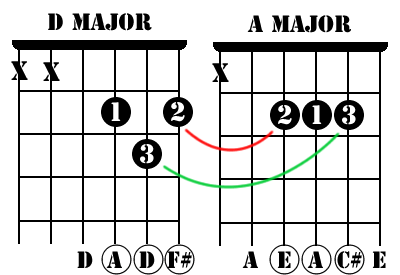 OK, one more example with a three chord progression, just 'cause I like you! Place your fingers on the fingerboard for the D minor (Dm) chord: 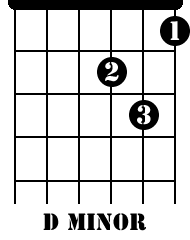 Now change to the Am chord:  Lastly, move into the E major chord (E): 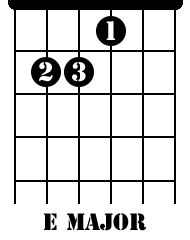 As you see, you have moved your fingers across the fingerboard, changing the strings that each finger presses for each chord, but the same general chord shape has been maintained. 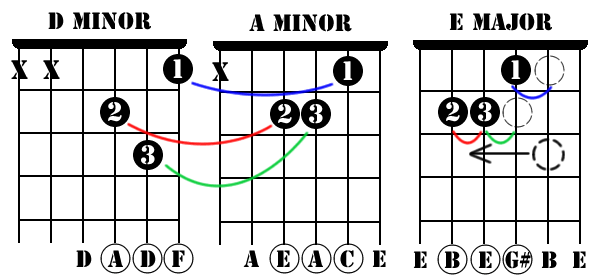 For each chord change, your index finger moves from the first string to the second, then from the second to the third, but maintains the same position on the fingerboard at the first fret. The same movement occurs for your middle finger, moving from string to string, maintaining position on the second fret. The only finger position movement happens with your ring finger as it moves from the second string (B) third fret to the third string (G) second fret. You see that the chord change from Am to E is merely lifting you fingers off the strings and shifting them up one string from strings 2, 3 and 4 to strings 3, 4 and 5. These are tiny changes in finger positions, and not difficult once you see how the chords interact. These are also very easy chord changes to practice. In fact, what a great idea! To get quick chord changes memorized in your finger muscles, set a metronome to 60 beats per minute (BPM) and practice changing chords. If that's too fast, slow the metronome down to 40 BPM. For each beat, change chords back and forth until they feel natural. Increase the speed of the metronome by 10 BPM after you are able to change the chords cleanly and consistently. Practice these chord changes for five to ten minutes a day and you'll be comfortable with hem inside of a couple weeks. Because our muscle memory works so well, once you know the shape for each chord, you'll be able to add new chords into the mix fairly easily and quickly. Give that a try, Daniel (and anyone else struggling with chord changes), and let me know how it works out. If you have questions, don't hesitate to ask. Ya'll have a great weekend, and as always, keep rocking! Peace~ Dave Dave "Eddie" Vance is a rock guitar enthusiast and gear nut. He has been playing guitar for over 30 years and enjoys tormenting the neighbors every chance he gets. When he's not slaving for the man, you can find him rocking out with his B.C. Rich Bich guitar, a cold beer and some sweet tunes. He also runs Learn-To-Play-Rock-Guitar.com, but you knew that already! Follow Learn To Play Rock Guitar:I welcome your feedback! Did you like today's message? What other topics would you like to see covered in my e-mails? Please let me know at: dave@learn-to-play-rock-guitar.com As always, please feel free to forward this email to a friend! I review products before recommending them. If you buy a product based on my recommendation, I will receive a commission. However, my emails also contain links that don’t require any investment on your part and are jam-packed with "juicy, guitar learnin' tastiness". We don't rent or share your name with anybody. Feel free to forward this issue to any friends you think would enjoy its contents. They will thank you. So will I.
|


